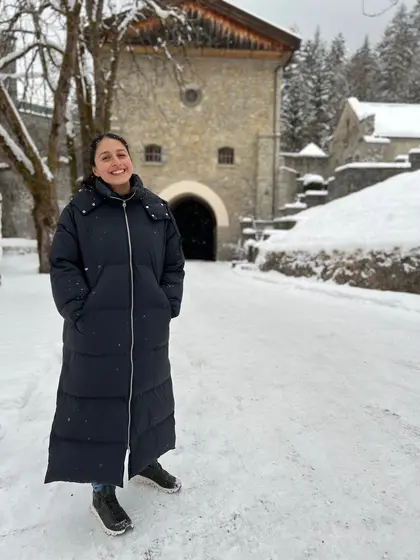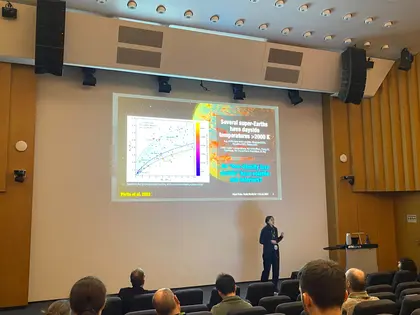
Q: What is your general field of study?
I am an astrophysicist who studies the atmospheres of exoplanets, which are planets that orbit stars other than the Sun—planets that exist outside our Solar System. As of now, we have detected over 5,000 of these planets, but there are many more to discover.
Before I can study an exoplanet’s atmosphere, we need to determine key pieces of information, including its size and mass. It’s actually quite amazing that we are able to get information about these planets at all, because most of the time we’re not even observing the exoplanets themselves. What we are looking at, through telescopes like NASA’s TESS and Kepler satellites, are these tiny pinpoints of light in the sky, which come from the exoplanet’s host star. Exoplanets orbit their host stars the same way the Earth orbits the Sun.
We are able to detect the size of the planet as the brightness of its host star changes over time. At regular intervals during a planet’s orbit, it will pass in front of its host star, relative to our vantage point. When it does this, it occludes patches of light from the star—much like the phenomenon of a solar or lunar eclipse—causing a dip in its brightness. We determine how big the planet is depending on how deep that dip is. In other words, the bigger the planet, the more light it will block and the dimmer the star will appear.
We measure a planet’s mass through a technique called the radial velocity method, which detects tiny wobbles in the star caused by the planet’s gravitational force as it orbits the star. From those wobbles, we are able to derive the planet-to-star mass ratio.
With these measurements, we can determine each planet’s size and mass relative to the planets in our own Solar System. For example, is it as big as Jupiter? Or is it a smaller Earth-like rocky planet? What we’ve discovered from all our recent surveys is that the most common type of exoplanet falls between the size of Earth and Neptune.
Once we know that a planet exists and we have its size and mass, that’s where my work in studying its atmosphere comes in. We do this through a technique called spectroscopy, using telescopes such as NASA’s HST and JWST. There are a few ways to do this, and one of them is called secondary eclipse spectroscopy. Every planet emits light, in the same way that hot coals ‘glow’. As a transiting exoplanet passes behind its host star, its ‘glow’ disappears and then reappears, allowing us to measure how much light the planet is emitting. HST and JWST allow us to look at this light at different wavelengths (i.e., colors), ranging from UV to infrared. We know that different molecules in the atmosphere react with light in different ways. As a result, these molecules leave ‘fingerprints’ at different wavelengths - we can then piece together which molecules are present in the atmosphere by looking for these tell-tale signatures. Some of the molecules we’ve detected so far include water vapor, methane and carbon monoxide.
Q: Did you always want to be a scientist?
My first encounter with science was when my dad got me a book for my second birthday with images of galaxies and nebulae from the Hubble Space Telescope. I was entranced by those pictures and have vivid memories of looking through the book with my dad. Since then, I’ve always had an interest in science. But as a kid I went through different phases in terms of “what I wanted to be when I grew up.” There was a time when I wanted to be a fiction author. And at another point I wanted to be an optician. By the time I was high school, though, I knew I’d pursue science.
Q: Was your love of science shaped by a particular experience or mentor?
My love of science essentially unfolded in three phases over the course of my academic career. While I was in high school, I read an article about cosmology and Stephen Hawking’s work, which really riveted and inspired me. It was the first time I encountered the concept of the “theory of everything,” and I was really eager to understand what that meant. But at the end of the article, it said something along the lines of, “we don’t know what the ‘theory of everything’ is yet. We’ll have to wait and see.” It was like the worst kind of cliffhanger and I was so frustrated. Hey, wait! What do you mean you don’t know? And so, I thought, if they’re not going to tell me, I’ll go find the answer myself. So that made me want to be a cosmologist, which became one of my main interests for several years. Then, when I was doing my undergrad, I did a summer project with Dr Grant Kennedy on debris disks around stars, which was in the context of learning about exoplanets. I really enjoyed that and it sparked my interest in exoplanets. The clincher was when I did a course on exoplanet atmospheres during my master’s. I found it really fascinating and that’s how I chose the focus of my Ph.D. In fact, the professor of that course, Prof. Nikku Madhusudhan, was instrumental in my decision and eventually became my Ph.D. supervisor.
Q: Who is your “Science Superhero?”
When I really think about it, my original science hero is the Hubble Space Telescope itself. Those images in the book my father gave me as a child are what ultimately inspired me to pursue astronomy.
Q: What is the coolest thing you’ve worked on so far in your career?
I’ve been really lucky to work on a lot of cool things, but there are a couple that stand out.
One area of study I’ve been really excited about relates to those exoplanets between the size of Earth and Neptune. We can divide that population into Super-Earths, which are up to around 1.6 times the size of Earth—and sub-Neptunes, which are roughly between two and four times the size of Earth.
Both super-Earths and mini-Neptunes are especially mysterious because they don’t exist in our Solar System, and yet they are extremely common among exoplanets. I’m really fascinated by the fact that these particular exoplanets are so different from anything we’ve seen in our Solar System, and I’m motivated to understand why they’re so different. Ultimately, if we are able to determine what these super-Earths are made of, we will be able to deduce how they formed in the first place and why the Solar System doesn’t have them.
Since joining Carnegie, I have been exploring a specific category of super-Earths that are less dense than the Earth. Ultimately, what we really want to determine is the interior composition of these exoplanets and what they look like. For example, are they a scaled-up version of Earth, like a big rocky planet? Or are they essentially a scaled-down version of Neptune, with a puffy, hydrogen-rich atmosphere? Or are they something completely different altogether? So, what are they? One theory is that they might be “water worlds”, hypothetical exoplanets where a huge fraction of their entire mass is made up of water. There are a few other theories, but something very interesting and unusual is going on. Unlike planets in our Solar System, which are much closer, we can’t use probes to see these exoplanets up close. We can measure the size and mass of their atmospheres using the techniques I mentioned earlier, but we are unable to directly observe their interior. This means we have to use indirect methods to unravel the mystery.
These low-density super-Earths span a whole range of temperatures, and I have chosen to focus on a subset that are really close to their host stars, even closer than Mercury is to the Sun. Because of their proximity to their host stars, they are being roasted all the time—as though they are right up against a fire—making them hot enough to melt rocks. The dayside of these planets, or the side that faces their host stars, is completely molten, like an ocean of lava. All of that heat would cause those lava oceans to evaporate from the surface, which means the exterior atmospheres of these planets would be made up of evaporated rock in the gas phase, which is very extreme. If the interior of the planet is evaporating, we can use our existing methods to measure the planet’s atmosphere to make determinations about the chemical composition of its interior.
The other thing I’m really excited about are the major breakthroughs JWST has afforded us in observing the atmospheres of exoplanets at wavelengths we didn’t have access to before, into the mid-infrared. Those wavelengths are particularly useful for learning about colder planets, as well as identifying new chemical information. The timing for me was perfect because JWST went into science operations about one and a half years ago, coinciding with my time at Carnegie.
I’ve been so lucky to have the opportunity to work on several data sets that come from this brand-new, shiny telescope. One amazing project, in particular, has been research around a sub-Neptune called GJ1214 b, which is enshrouded in thick clouds and/or hazes, making its atmosphere really opaque. While the planet has been observed extensively in the past, especially with instruments like the Hubble Space Telescope, those instruments weren’t able to penetrate the haze. JWST’s infrared capabilities, however, have allowed us to break through that blanket of cloud/haze and make some really interesting observations.
For one thing, its atmosphere looked even colder than we expected. We came to realize this colder temperature is a result of its very shiny surface, which reflects a lot of the light it’s receiving from its host star. In fact, it is estimated that approximately 50 percent of the light reaching the planet from the star is reflected back into space. That reflected light is a result of the haziness of its atmosphere. JWST has allowed us to measure the light emanating from the planet at mid-infrared wavelengths and we were able to detect evidence of water vapor—or possibly methane, which looks similar to water in the JWST data. What we do know is that the planet’s atmosphere is made up of a heavier molecule like water or methane, not lighter hydrogen. These brand-new observations will be instrumental in helping us better comprehend that planet’s formation, as well as deepening our understanding of the sub-Neptune population overall.

Q: What do you think is the most exciting research direction happening in your field right now?
As I mentioned, JWST has created this huge wave of new observations and is allowing us to do things we’ve never been able to do before. I think that wave will continue for quite a while; it’s keeping us all really busy.
Q: Looking 10 years ahead, what future development do you think will have the greatest impact on your field?
There are two sides of the coin.
First, there are the continuing advancements in our observational capabilities. In the same way that JWST represents a huge step forward in our current capabilities, we will continue to see the development of bigger, more advanced instruments that will allow us to look at different wavelength ranges and lead to all new discoveries. There are very large ground-based telescopes under construction right now that will be game changers, including the Giant Magellan Telescope, a project in which Carnegie is involved, and the Extremely Large Telescope, which will be part of the European Southern Observatory. In addition, NASA’s next big flagship space-based telescope, the Habitable Worlds Observatory (HWO), will be really pivotal in the study of exoplanets.
The other side of the coin is a big shift in our approach to the theoretical and modeling side. Recently, the exoplanet community has begun sharing knowledge and communicating more and more with scientists from a multitude of other fields like geophysics, geochemistry, Solar System science, and Earth science, to name just a few. These interdisciplinary collaborations have been really informative in my field because the study of exoplanets ultimately involves understanding every part of these planets, including their interiors, geologies, and (dis)similarities to the Solar System. There is a lot to learn in both directions!
Q: Do you have a favorite exoplanet and why?
What inspires me and drives my research is more about the overall diversity of the exoplanet population, and less about any one individual planet on its own. I’m fascinated by the collective and how different they all are from one another. That said, at the moment I’m really excited about an exoplanet called TOI-561 b, which we’ll be observing with JWST this year. I worked on a proposal for this project with the project’s P.I. Johanna Teske, a Staff Scientist at Carnegie, along with a team of other people. The reason it’s so interesting is that while it’s a super-Earth planet, it’s less dense than just a rocky planet. We think that might be attributable to the presence of water, yet it’s also really, really hot; it’s one of those lava worlds that have molten surfaces. The project I’ve been leading on the atmospheres of lava worlds is a theory paper that’s geared toward determining what we should look for when we observe these super-hot exoplanets. Now that we have the opportunity to observe this one, my contribution to the project will be using my models to interpret the data we receive to determine if we can detect signs of water or perhaps carbon dioxide—something that would make this planet very unique compared to the rocky planets in the Solar System.
Q: What are some of the challenges you have encountered in your career so far and how did you manage them?
Toward the end of my undergrad, I got very serious tendonitis in both my arms, which left me unable to write or type for almost two years. I actually had to take some time off. And then, even though I hadn’t recovered, I decided to go back and finish my degree and did the last year of my bachelor’s without the ability to physically write. I had no idea how I was going to do it but I managed to make it work with a variety of approaches, including using dictation software—and let’s just say that dictation software does not lend itself to anything involving math. It was really tough, but I put one foot in front of the other and I got through it. In retrospect, I am actually glad that happened because it gave me the confidence to go into a situation and think, I don’t know if this is going to work but I’m going to try it anyway. It taught me to persevere in the face of uncertainty.
Q: What advice would you give to graduate students and others who are just starting their scientific careers?
Seek out and stay in touch with good mentors. Not only can you learn a great deal from them, but they can encourage you to keep going during the tough times. Looking back on my career, I see all these moments when I almost gave up because I didn’t think I was good enough. It’s the dreaded imposter syndrome. Something that has really helped with that is that every time I thought, oh I don’t think I can do this, I’ve had a mentor say, “yes you can do this. Go do it.” As a student, I often felt that by asking for help or advice I was imposing on people’s time. However, what I’ve learned as I’ve progressed in my career is that I actually enjoy helping others, whether that be students coming up in their own careers or peers. So, for anyone who’s reluctant to seek mentorship or advice, don't be, because you’ll find so many people who will welcome the opportunity to help and encourage you, even if it's just to say, “Good job!”. We all need to hear that sometimes.
Q: Why did you decide to do a postdoctoral position at Carnegie?
I was really drawn to the Earth and Planets Laboratory at Carnegie because it is so interdisciplinary, which has allowed me to work with experimental geochemists, experts in planetary interiors, and scientists from other areas. It has become really clear—especially in my area of study—that we need to incorporate learnings about the Solar System, the Earth, and other fields to better understand the data that we are getting on exoplanets and to learn about the composition of their interiors.
Q: What has your experience at Carnegie meant to you?
If I look back on my time here, I really value that I’ve had the space to be creative in my work. The main project I’ve worked on at Carnegie is a little different from what I’ve done in the past because it incorporates research into planetary interiors and surfaces, and it has been really exciting to have the flexibility to experiment and explore these new ideas. This is also the first time I’ve spent an extended period in the U.S. and it has been a lot of fun to “do science” in a different culture. The great thing about science is that you get to work with people from all over the world, and I really enjoy the opportunity to talk to people and experience life in different countries. It really helps you understand and appreciate how everyone is different and teaches you to be compassionate. One last thing is that this organization really prepared me well for the next step in my career. I just got a faculty position back in the U.K. at the University of Birmingham and I received so much support from people at Carnegie while applying for jobs—something for which I am so grateful.
